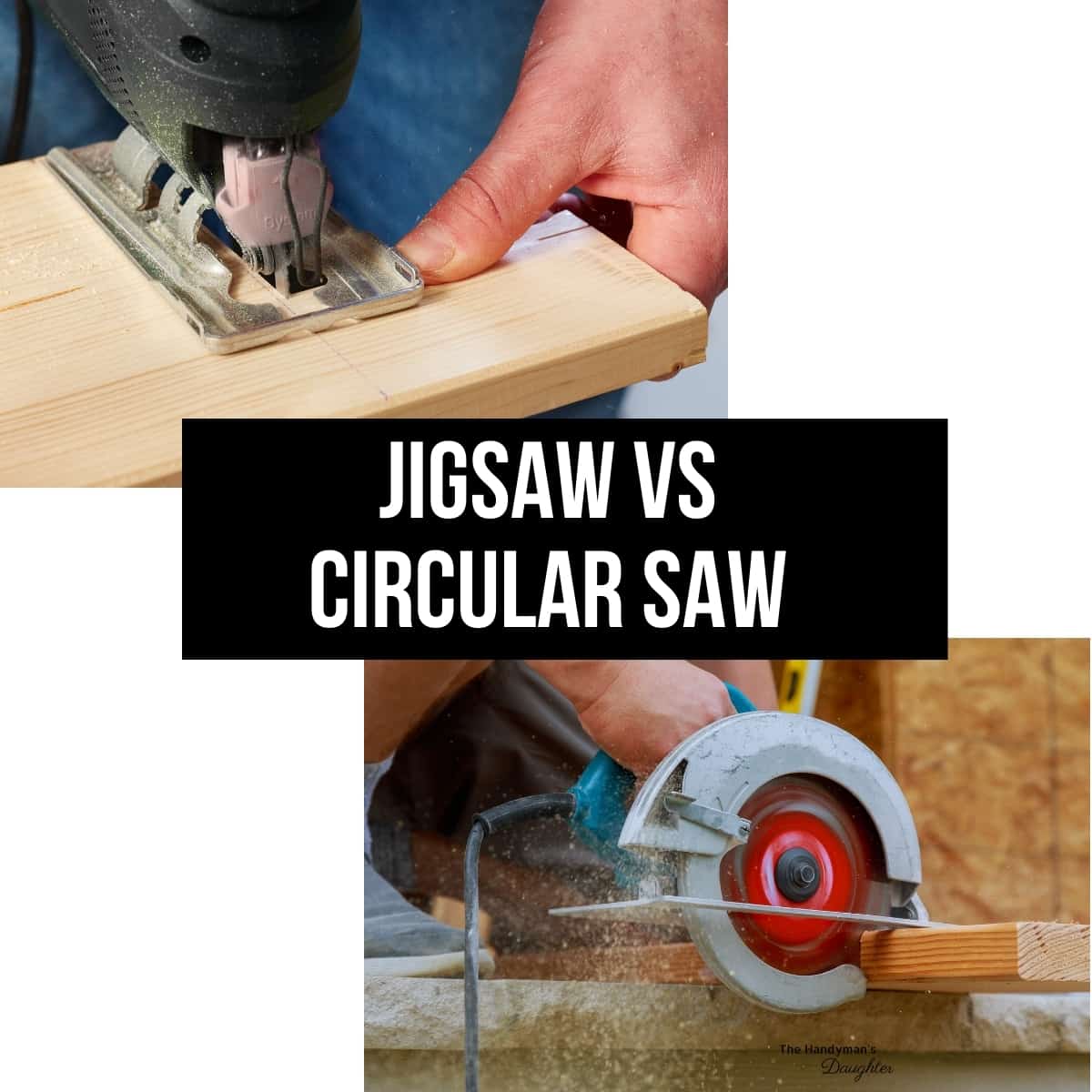When it comes to woodworking and DIY projects, knowing which tools to use can make all the difference. So, when should you reach for a jigsaw and when should you grab a circular saw? Let’s dive in and explore the advantages and best applications for each of these powerful tools.
When to use a jigsaw versus a circular saw? This is a common question among woodworking enthusiasts and beginners alike. Well, imagine this: you’re working on a project that requires cutting intricate curves or shapes in a thin piece of material. That’s where a jigsaw shines! Its narrow blade allows for precise and intricate cuts, making it perfect for tasks like cutting out patterns, creating notches, or making intricate designs.
On the other hand, there are times when a circular saw is the tool of choice. If you’re tackling a project that involves cutting straight lines through thicker materials like plywood or lumber, a circular saw is your best friend. With its powerful motor and robust blade, a circular saw can effortlessly slice through those thick pieces, saving you time and effort. So, if you need to make long, straight cuts, a circular saw will get the job done in a jiffy.
So, whether you’re embarking on a woodworking project or a crafty DIY endeavor, knowing when to use a jigsaw versus a circular saw is key to achieving professional results. In the next sections, we’ll delve deeper into the specific applications for each tool, providing you with the knowledge to make informed decisions and unleash your creativity. Let’s get started!
| Jigsaw | Circular Saw |
| Great for curved cuts and intricate designs | Ideal for straight, long cuts in various materials |
| Lightweight and maneuverable | More powerful and suitable for heavy-duty cuts |
| Can cut through thin materials like plywood | Efficient in cutting thick boards or lumber |
| Allows for precise cuts with less kickback | Produces fast and straight cuts |
| Performs detailed cuts for intricate woodworking | Perfect for framing and general construction |
Explore the unique features of each tool to determine when to use a jigsaw or a circular saw.

When to Use Jigsaw vs Circular Saw: The Ultimate Guide
Are you a DIY enthusiast or a professional woodworker? Then you know the importance of choosing the right tools for the job. When it comes to cutting wood, two popular options are the jigsaw and the circular saw. While they both serve similar purposes, they have distinct differences that make them more suitable for certain tasks. In this comprehensive guide, we will explore when to use a jigsaw versus a circular saw, comparing their features, benefits, and limitations. By the end of this article, you’ll be able to confidently choose the right tool for your woodworking projects.
The Versatility of Jigsaw: When to Choose the Jigsaw
When it comes to versatility, the jigsaw takes the crown. This handheld power tool allows for intricate and precise cuts, making it ideal for curved, irregular, or detailed designs. Here are some scenarios where the jigsaw shines:
1. Detailed and Intricate Cuts
One of the main advantages of a jigsaw is its ability to make detailed and intricate cuts. With its narrow and fine blade, the jigsaw allows you to cut curves, circles, and even intricate shapes with ease. This makes it perfect for projects like cutting out patterns, making scrollwork, or creating decorative designs on wood.
When working with a jigsaw, it’s important to choose the right blade for the material you’re cutting. For example, a fine-tooth blade works best for cutting wood, while a blade with larger teeth is more suited for cutting metal or plastic.
2. Cutting in Tight Spaces
Thanks to its small size and maneuverability, the jigsaw is excellent for cutting in tight or hard-to-reach areas. Whether you need to make cuts near walls or in confined spaces, the jigsaw’s compact design allows for greater control and precision. This makes it a popular choice for tasks like cutting holes for electrical outlets, fitting trim, or making plunge cuts.
3. Creating Bevels and Angled Cuts
If your project requires bevels or angled cuts, the jigsaw is the tool for the job. With a tilting base or adjustable shoe, the jigsaw can easily cut at different angles, allowing you to create beveled edges, chamfers, or mitered corners. This is particularly useful when working on projects like installing baseboards, creating picture frames, or constructing furniture with angled joints.
The Power of the Circular Saw: When to Choose the Circular Saw
While the jigsaw thrives in versatility and precision, the circular saw excels in power and speed. This handheld or table-mounted tool is known for its ability to make straight and long cuts effortlessly. Here are some situations where the circular saw reigns supreme:
1. Long, Straight Cuts
When it comes to cutting long, straight lines, the circular saw is king. Equipped with a large, round blade, this tool can quickly slice through large pieces of wood, making it ideal for tasks like cutting plywood sheets, framing walls, or building decks. Its power and efficiency make it a favorite among construction professionals and carpenters.
2. Rip Cuts and Crosscuts
The circular saw’s design and blade angle make it perfect for rip cuts and crosscuts. Whether you need to cut boards lengthwise (ripping) or across the grain (crosscutting), the circular saw’s ability to make straight and precise cuts ensures efficient and accurate results. This makes it a go-to tool for tasks like building furniture, installing hardwood flooring, or sawing thicker materials.
3. Efficiency and Speed
If you’re looking to complete your woodworking project quickly and efficiently, the circular saw is the way to go. Its powerful motor and large cutting capacity help you breeze through materials, reducing your overall cutting time. This is particularly beneficial for large-scale projects or when dealing with tough materials like hardwood or thick boards.
Additional Factors to Consider: Material, Skill Level, and Budget
While the jigsaw and circular saw have their own strengths, there are a few additional factors to consider before making your decision. These factors include the type of material you’ll be cutting, your skill level, and your budget.
1. Material
The type of material you’re working with can heavily influence which tool you should choose. If you primarily work with thin materials, like plywood or softwood, the jigsaw is a great option. Its ability to make intricate cuts and maneuverability makes it perfect for these materials. On the other hand, if you work with thick or dense materials, like hardwood or thick boards, the circular saw’s power and speed will be more beneficial.
2. Skill Level
Your skill level plays a role in determining the right tool as well. If you’re a beginner or someone who prefers a more forgiving tool, the jigsaw is a good starting point. Its maneuverability and versatility allow for easy learning and experimentation. However, if you have more experience or are comfortable handling powerful tools, the circular saw can provide faster and more efficient results.
3. Budget
Finally, your budget is an important factor to consider. Jigsaws are generally more affordable than circular saws, making them a budget-friendly choice for those just starting out. Circular saws, especially high-quality ones with additional features, can be more expensive. However, they often offer better durability and cutting performance in the long run, making them a worthwhile investment for professionals or frequent users.
Tips and Tricks for Using Jigsaws and Circular Saws
Now that you have a better understanding of when to use a jigsaw versus a circular saw, here are some tips and tricks to enhance your cutting experience:
1. Safety First
Always prioritize safety when using power tools. Wear protective equipment such as goggles, gloves, and ear protection. Familiarize yourself with the tool’s safety features and follow proper operating procedures.
2. Choose the Right Blade
Using the correct blade for the material you’re cutting is crucial. Different blades are designed for different materials, such as wood, metal, or plastic. Make sure to choose the appropriate blade to ensure clean and efficient cuts.
3. Secure Your Workpiece
Before making any cuts, securely clamp or hold down your workpiece to prevent it from moving or slipping. This will increase safety, accuracy, and overall cutting performance.
4. Mark Your Cut Line
Prior to cutting, mark your desired cut line on the material. This helps you follow a precise path and ensures that your cuts are accurate and aligned.
5. Take Your Time
When using a jigsaw or circular saw, it’s important to take your time and maintain a steady pace. Rushing through cuts can lead to mistakes or uneven results. Remember, practice makes perfect!
By understanding the strengths and weaknesses of both the jigsaw and circular saw, as well as considering the material, skill level, and budget factors, you can confidently choose the right tool for your woodworking projects. So, next time a project comes your way, you’ll know exactly when to reach for the jigsaw or the circular saw. Happy cutting!
Key Takeaways: When to Use Jigsaw vs Circular Saw?
– Use a jigsaw when cutting intricate shapes, curves, or patterns in thin materials like plywood or plastic.
– Use a circular saw for making straight cuts or cutting through thicker materials like lumber or plywood.
– Jigsaws are ideal for projects that require precision and detailed cuts.
– Circular saws are more suited for larger cuts and projects that prioritize speed.
– Consider the material, cut type, and project requirements to determine whether to use a jigsaw or circular saw.
Frequently Asked Questions
When it comes to woodworking and construction, choosing the right tool for the job is essential. This FAQ section will help you understand when to use a jigsaw versus a circular saw. Let’s dive in!
1. What types of cuts are best suited for a jigsaw?
The jigsaw is perfect for making intricate curved and irregular cuts. Its thin and narrow blade can easily maneuver through tight corners and complex shapes. Whether you’re cutting a decorative pattern or making cutouts in materials like wood or metal, the jigsaw is your go-to tool. Additionally, its ability to make plunge cuts, where you start cutting from the middle of the material, is a unique feature of the jigsaw.
However, keep in mind that the jigsaw may not provide the cleanest and most precise cuts for straight lines or long, straight edges. For those types of cuts, a circular saw might be a better option.
2. When should I use a circular saw instead?
The circular saw excels at making straight cuts quickly and accurately. Its circular blade, which spins at high speeds, can power through various materials with ease, such as wood, plywood, metal, and plastic. If you need to make long, straight cuts or rip boards to width, the circular saw is the ideal tool for the job.
However, the circular saw might not be the best choice for intricate or curved cuts. Its larger blade size and limited ability to maneuver in tight corners make it less suitable for those types of cuts. In those cases, you’d be better off using a jigsaw.
3. Can I use either tool for bevel cuts?
While both the jigsaw and the circular saw can make bevel cuts, their ease of use and precision might differ. The jigsaw usually has an adjustable shoe that allows for easy bevel cuts on both sides, making it a versatile choice. With the jigsaw, you can create beveled edges or angles on materials like wood or laminate.
On the other hand, the circular saw typically requires a bevel guide or an adjustable angle feature. While it can certainly make bevel cuts, it may not be as precise or straightforward as with a jigsaw. So, if your project involves extensive bevel cuts, the jigsaw might be the better option.
4. Which tool is more suitable for working in tight spaces?
When it comes to maneuverability in tight spaces, the jigsaw outshines the circular saw. The jigsaw’s smaller size and narrow blade allow for more flexibility and easy access to confined areas. Its ability to make intricate cuts and navigate curved lines make it a valuable tool when working in tight and hard-to-reach spaces.
On the other hand, the circular saw’s larger size and blade diameter make it less practical for tight spaces. It requires more room to make straight cuts and might not provide the necessary precision for intricate work in confined areas. So, if you’re working in a small or cramped space, the jigsaw should be your tool of choice.
5. Are there any safety precautions I should take when using these tools?
When working with power tools like the jigsaw and the circular saw, safety should always be a top priority. Here are some essential precautions to follow:
Firstly, always wear appropriate safety gear, including safety goggles or glasses, ear protection, and gloves, to protect yourself from flying debris and loud noise. Secondly, make sure to read and follow the manufacturer’s instructions for each tool. Familiarize yourself with the tool’s features, controls, and safety mechanisms.
Lastly, take extra caution when cutting, keeping your hands and fingers away from the blade. Use clamps or other secure methods to hold the material in place, ensuring a firm and stable cutting surface. Always unplug or turn off the tool when not in use, and never leave it unattended. By following these precautions, you can minimize the risk of accidents and ensure a safe working environment.

CIRCULAR SAW VS. JIGSAW…Which One Should You Own?! (FULL COMPARISON—New DIYers Should Watch!!)
Summary
So, when should you use a jigsaw and when should you use a circular saw? Let’s break it down.
If you need to make curved cuts or intricate designs, grab that jigsaw. It’s perfect for cutting shapes and getting into tight corners.
On the other hand, if you’re working with large pieces of wood and need straight cuts, reach for the circular saw. It’s great for making long, straight cuts quickly and efficiently.
Remember, safety always comes first when using power tools, so be sure to follow proper precautions and wear the appropriate protective gear. Happy sawing!
